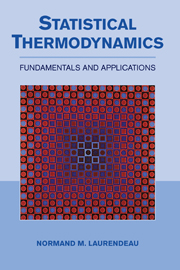Book contents
- Frontmatter
- Contents
- Preface
- 1 Introduction
- PART ONE FUNDAMENTALS OF STATISTICAL THERMODYNAMICS
- PART TWO QUANTUM MECHANICS AND SPECTROSCOPY
- PART THREE STATISTICAL THERMODYNAMICS IN THE DILUTE LIMIT
- 8 Interlude: From Particle to Assembly
- 9 Thermodynamic Properties of the Ideal Gas
- Problem Set IV Thermodynamic Properties of the Ideal Gas (Chapters 8–9)
- 10 Statistical Thermodynamics for Ideal Gas Mixtures
- 11 Concentration and Temperature Measurements
- Problem Set V Chemical Equilibrium and Diagnostics (Chapters 10–11)
- PART FOUR STATISTICAL THERMODYNAMICS BEYOND THE DILUTE LIMIT
- PART FIVE NONEQUILIBRIUM STATISTICAL THERMODYNAMICS
- PART SIX THE ENSEMBLE METHOD OF STATISTICAL THERMODYNAMICS
- PART SEVEN APPENDICES
- Index
9 - Thermodynamic Properties of the Ideal Gas
Published online by Cambridge University Press: 05 June 2012
- Frontmatter
- Contents
- Preface
- 1 Introduction
- PART ONE FUNDAMENTALS OF STATISTICAL THERMODYNAMICS
- PART TWO QUANTUM MECHANICS AND SPECTROSCOPY
- PART THREE STATISTICAL THERMODYNAMICS IN THE DILUTE LIMIT
- 8 Interlude: From Particle to Assembly
- 9 Thermodynamic Properties of the Ideal Gas
- Problem Set IV Thermodynamic Properties of the Ideal Gas (Chapters 8–9)
- 10 Statistical Thermodynamics for Ideal Gas Mixtures
- 11 Concentration and Temperature Measurements
- Problem Set V Chemical Equilibrium and Diagnostics (Chapters 10–11)
- PART FOUR STATISTICAL THERMODYNAMICS BEYOND THE DILUTE LIMIT
- PART FIVE NONEQUILIBRIUM STATISTICAL THERMODYNAMICS
- PART SIX THE ENSEMBLE METHOD OF STATISTICAL THERMODYNAMICS
- PART SEVEN APPENDICES
- Index
Summary
To this point, our study of statistical thermodynamics has provided a methodology for determining the most probable macrostate when considering an isolated system of independent particles. The most probable macrostate, in turn, has spawned mathematical definitions for both the internal energy and entropy in the dilute limit, thus producing general analytical expressions for all intensive thermodynamic properties of the ideal gas, as discussed in Chapter 4. These properties are inherently expressed in terms of the partition function, which mandates information on those energy levels and degeneracies associated with a particular atom or molecule. Obtaining such data has provided the rationale for our study of quantum mechanics and spectroscopy. Now that we have access to the necessary spectroscopic information, we are finally prepared to calculate the properties of the ideal gas. We begin, for simplicity, with the monatomic gas, which requires only knowledge connected with the translational and electronic energy modes. We then move on to the diatomic gas, which demands additional information based on the rotational and vibrational energy modes. Finally, we consider the polyatomic gas, which thus far has received little attention in our deliberations related to either statistical thermodynamics or quantum mechanics.
The Monatomic Gas
Typical monatomic gases include the noble gases, such as He and Ar, and elemental radicals, such as atomic oxygen and nitrogen. For such gases, rotation and vibration are irrelevant; thus, we need only consider the translational and electronic energy modes.
- Type
- Chapter
- Information
- Statistical ThermodynamicsFundamentals and Applications, pp. 169 - 200Publisher: Cambridge University PressPrint publication year: 2005



